Reasons to Buy Tamron 16-300mm F3.5-6.3 Di II VC PZD Macro Lens
Here we’ve included a summary of the advantages and disadvantages of the Tamron 16-300mm F3.5-6.3 Di II VC PZD Macro lens in a list form to help you determine whether it offers the features you need.
PROs
| Optical Image Stabilization |
| Weather-sealed |
| Autofocus |
| Distance Scale |
| Hood supplied |
| Full-time Manual Focusing |
| Zoom Lock |
| Versatile Lens with a Zoom Ratio of 18x |
Report a correction
Buy Tamron 16-300mm f3.5-6.3 II VC PZD from or B&H PHOTO
CONs
| Lens Extents while zooming |
| Slow Aperture at Tele end |
| Variable Aperture |
Lens Mount
Tamron 16-300mm f3.5-6.3 II VC PZD is compatible with cameras that have a Canon EF lens mount. Some of the latest released cameras that are compatible with the Canon EF lenses are Canon T8i, Canon 90D and Canon SL3.
Tamron 16-300mm f3.5-6.3 II VC PZD is also available in Nikon F (DX) and Sony Alpha mounts.
Size, Weight and Filter Thread
Size and weight is a very important decision factor when searching for your next lens. Tamron 16-300mm f3.5-6.3 II VC PZD has a maximum diameter of 75mm and total length of 100mm when not extended. It weighs 540g / 19.0 oz.
Tamron 16-300mm f3.5-6.3 II VC PZD has a filter thread of 67mm. Below are links to the filters that we recommend you to consider for your Tamron 16-300mm f3.5-6.3 II VC PZD:
Optical Image Stabilization
The Tamron 16-300mm f3.5-6.3 II VC PZD features an optical image stabilization system which helps to reduce the blur that occurs due to shaking during hand-held shooting.
Zoom Method
Tamron 16-300mm f3.5-6.3 II VC PZD features Rotary (extending) zoom method where the length of the lens changes as you zoom in or out. This makes it possible to design the lens with a smaller minimum length ( generally when it is zoomed out) compared to internal zoom lenses. The disadvantages of this design are being harder to seal against dust and moisture, weight balance shifting while zooming and zoom creep in certain lenses.
Zoom Lock
Tamron 16-300mm f3.5-6.3 II VC PZD has a Zoom lock feature which eliminates Zoom creep where focal length of the lens changes with gravity when it’s held downwards or upwards.
Maximum Magnification Ratio
Tamron 16-300mm f3.5-6.3 II VC PZD has a Max Magnification Ratio of 0.34x and has a minimum focusing distance of 0.39m. For a non-macro lens, the 0.34x is considered a high magnification and will come handy for close-up shots.
Aperture
Tamron 16-300mm f3.5-6.3 II VC PZD is a variable aperture lens with a max aperture of f3.5 and a minimum aperture of f22 at 16mm, and a max aperture of f6.3 and minimum aperture of f40 at 300mm .
| Focal Length | Max Aperture | Min Aperture |
|---|---|---|
| 16mm | F3.5 | F22 |
| 300mm | F6.3 | F40 |
Lens Hood
Tamron 16-300mm f3.5-6.3 II VC PZD comes with a removable lens hood which is handy to reduce lens flare and glare in your photos.
Popular Comparisons of Tamron 16-300mm f3.5-6.3 II VC PZD
Top Alternatives of Tamron 16-300mm f3.5-6.3 II VC PZD Lens
| Model | Coverage | Weight | Focusing | Street Price | |
|---|---|---|---|---|---|
|
Tamron 18-270mm F3.5-6.3 Di II VC PZD Compare |
APS-C / DX | 450 g / 0.99 lb | AF | ||
|
Tamron 18-400mm F3.5-6.3 Di II VC HLD Compare |
APS-C / DX | 710 g / 1.56 lb | AF | ||
|
Canon EF-S 18-135mm F3.5-5.6 IS USM Compare |
APS-C / DX | 515 g / 1.13 lb | AF | ||
|
Sigma 18-300 F3.5-6.3 DC Macro OS HSM Compare |
APS-C / DX | 585 g / 1.29 lb | AF | ||
|
Nikon AF-S DX NIKKOR 18-300mm F3.5-6.3G ED VR Compare |
APS-C / DX | 550 g / 1.21 lb | AF | ||
|
Tamron AF 18-270mm F3.5-6.3 Di II VC LD Aspherical IF MACRO Compare |
APS-C / DX | 560 g / 1.23 lb | AF | ||
|
Canon EF-S 18-135mm f3.5-5.6 IS Compare |
APS-C / DX | 455 g / 1.00 lb | AF | ||
|
Canon EF 28-300mm f3.5-5.6L IS USM Compare |
35mm FF | 1,670 g / 3.67 lb | AF |
Tamron 16-300mm f/3.5-6.3 Di II VC PZD Macro review – Our verdict
Broadly speaking, there are two extremes of photographer in this world – the happy snapper and the pixel-peeper. The pixel-peeper is serious about technical quality and is prepared to sacrifice convenience to achieve what he believes is perfection. The happy snapper enjoys taking pictures and isn’t too worried about the finer points of quality, but wants to be able to enjoy his hobby.
This Tamron 16-300mm f/3.5-6.3 Di II VC PZD Macro lens is definitely one for the happy snapper, and not for those who prefer to look at the pixels. It is a reasonably priced piece of kit that happy photographers will attach to their cameras and rarely remove, and it will always be convenient and allow them to get the shots they want to take. They won’t be enlarging to A2 very often, and will, in the main, remain extremely happy with their purchase. There are a lot of photographers in this bracket, and Tamron will be very successful with this lens.
Specific optical characteristics
Macro
Despite the macro tag, no zoom is a true macro lens, and superzooms don’t come anywhere near. But the Tamron does focus decently close, down to 9cm (3.5 in) from the front element, and at 300mm focal length setting (way less than 300mm in reality — see Focus Breathing below) that’s enough to fill the frame with a subject 6cm wide (2.4 in) — just perfect for subjects like flower portraits (see bokeh example, below).
Sharpness is not at its best here, with edges and corners particular soft and there’s noticeable pincushion distortion, though field flatness is well controlled. No problem for the kind of things this feature is likely to be used for, especially when depth of field is so shallow that everything apart from the main subject will probably be out of focus anyway.
Flare
|
Flare resistance is good, comparing well in side by side tests with premium grade zooms. There’s minimal spreading of the bright zone, the branches have not been completely bleached out, and there’s only one blue/green flare spot in this example (at lower right). Canon 7D, 17mm, 1/800 sec, f/8, ISO 100. |
Resistance to flare is high, with good control of veiling glare, colored flare spots and ghosting, when shooting into very bright light. Though far from immune, the Tamron compared well in side by side tests against some of Canon’s L-grade zooms. Testament to the efficiency of Tamron’s BBAR multi-coating and good attention to internal baffling.
Focus Breathing
The stated focal length of a lens is only technically true at infinity focusing distance. ‘Focus breathing’ is a reduction in focal length at closer range, as a consequence of the internal focusing (IF) mechanism used to keep the overall length of the lens down. All IF lenses do it to some extent, but superzooms are known to be particularly prone as manufacturers push the limits to reduce bulk.
It’s not normally a problem, as it’s only significant at maximum focal length at distances below about 3m (10 ft) in situations where it’s not possible to move closer — subjects like small garden birds is a good example. Comparing the Tamron’s actual field of view at 300mm against what it should be at a focusing distance of 3m (10 ft) gave an estimated effective focal length of just 205mm, and that reduces still further towards the minimum focusing distance.
Background blur
One genuinely desirable, but difficult to measure aspect of lens performance is the ability to deliver smoothly blurred out-of-focus regions when trying to isolate the subject from the background, generally when using a large aperture and long focal length.
|
Superzooms are not the best choice for bokeh fans, with modest maximum apertures usually creating quite deep depth-of-field. But with the Tamron’s longer focal length, the narrower field-of-view gives good subject isolation, greatly enhancing the bokeh effect at 300mm, particularly at closer shooting distances. 300mm, 1/13 sec, f/6.3, ISO 100, on Canon 7D. |
|
|
The Tamron focuses closer than most superzooms, down to 9cm (3.5 in) from the front of the lens. At 300mm focal length setting, it delivers a maximum magnification of 0.34x. Or to put that another way, it will fill the frame on APS-C format with a subject 6cm (2.4 in) wide. This small rose would fit easily in the palm of your hand. 300mm, 1/8 sec, f/11, ISO 100, on Canon 7D. |
Tamron 16-300mm f/3.5-6.3 Di II VC PZD Macro review
There was a time when bridge cameras were all the rage. This was the time when digital SLRs were a massive price, and digital compacts were not quite up to the job. It was also when the term ‘bridge camera’ was invented, because these all-in-one, multi-purpose zoom-lens cameras were literally a causeway, a step, a holding area, for photographers who really wanted a DSLR but who couldn’t justify the price.
When DSLRs eventually became more affordable, some manufacturers, Canon in particular, were surprised that there was still a demand for bridge cameras. People liked, and still do like, the convenience of a camera that does what a DSLR does, but which never needs the lens changing and never needs a bag to carry the extra lenses they no longer need.
A fear of dust on imaging sensors was another massive plus point for bridge cameras, as they never had to expose their innards to the elements. Also, people generally liked the convenience, while swallowing the disadvantages of the bridge camera’s inevitably smaller sensor.
Bridge cameras these days have much larger sensors, but you can get that same ‘bridge effect’ with an APS-C or full-frame DSLR if you find the right lens. Get a zoom that covers every focal length you will ever want to use, stick it on the camera and you’ll never have to take it off. This presents all the advantages of having a bridge camera, but with the quality advantage that a larger sensor affords. Great idea? Well, Tamron knows there are enough people who will think that it is for the company to justify the production of this all-encompassing 16-300mm mega-zoom.
While there are certainly advantages to using an APS-C sensor, there will also be costs in having a zoom with such a range. Unfortunately, the laws of optics dictate that some of those costs will be higher in a lens designed for APS-C sensors than they are for those designed for the thumbnail-sized sensors of the original bridge models.
Studio Tests
Tamron has done a good job with the optical redesign, increasing focal length at both ends of the scale, and delivering better sharpness than the preceding Tamron 18-270mm F3.5-6.3 Di II VC PZD, even if there’s not a great deal in it. Like all superzooms, the Tamron 16-300mm F3.5-6.3 Di II VC PZD Macro is sharpest at shorter focal lengths, and less so at longer settings.
Sharpness
At wider focal lengths, sharpness is excellent in the center, and across the frame at around F5.6-8. As focal length is increased, sharpness reduces, taking more of a hit towards the edges where it’s decidedly soft above 200mm. F8 is the overall optimum aperture and will always deliver decent sharpness in the centre, even at 300mm.
Chromatic Aberration
| Chromatic aberration (CA) is never far away, and most prominent at shortest and longest focal lengths. It’s very noticeable here around the rear wheel. 16mm, 1/200 sec, f/8, ISO 100, on Canon 7D. |
A generous helping of chromatic aberration is to be expected with a superzoom. There’s strong magenta/green towards the edges at wide-angle, reducing to low levels through 50-100mm, before returning with a vengeance from 200-300mm. Canon DSLRs won’t correct for it in JPEGs (Nikon DSLRs will try to) but it can be neutralized very effectively in your average Raw conversion software, provided you don’t mind putting in a little time on a computer.
Vignetting
Smaller formats like APS-C are kind to vignetting, especially with the modest maximum apertures of a superzoom. Basically it’s not a problem here, with the worst figure being 1.3 stops of darkening in the extreme corners at 16mm f/3.5, and even that is hardly serious.
Distortion
Plenty of distortion present, with strong +3.2% barreling at 16mm, transitioning through neutral at 18-20mm, then on to almost equally strong pincushion distortion at longer focal lengths, easing off slightly to around -2% at 200-300mm. This is very noticeable in critical subjects like architecture, but easily corrected in software.
Tamron 16-300mm f/3.5-6.3 Di II VC PZD Macro Verdict
Not only have Tamron delivered a lens that offers a uniquely huge zoom range, but they’ve managed to make one that performs well, is well specified, and is good value too.
Although those who will only really be sated by the absolute sharpest of lenses may not be overly excited by this lens, those who value convenience will find this lens is more than adequate for general photography. The compact size, light weight and splash proof construction make this lens an ideal travel companion, and the lens’ ability to focus down to 39cm makes frame-filling close-ups possible.
Overall, this is a very versatile lens, which should win over many fans.
|
|
||
|
The Tamron 16-300mm f/3.5-6/3 offers a uniquely huge 18.8x zoom range, performs well, delivers good value for money and has impressive close up focus performance making this an ideal travel zoom lens. |
Tamron 16-300mm f/3.5-6.3 Di II VC PZD Macro Pros
Very good sharpness in the centreExtreme 18.8x zoom rangeEffective VC systemGood build and splash proof constructionCompact and lightweightFocuses very close for a lens that covers 300mm
Tamron 16-300mm f/3.5-6.3 Di II VC PZD Macro Cons
CA levels towards edges of the frame are high at 300mmPerformance towards the edges of the frame falls behind at 18mm and 300mm
| FEATURES | ||
| HANDLING | ||
| PERFORMANCE | ||
| VALUE FOR MONEY | ||
| VERDICT |
Product Highlights
- A further expansion of the imaging range. With a minimum focal length of 16mm (35mm film equivalent: 24.8mm) at the wide-angle end of the zoom range, and a maximum focal length of 300mm (35mm film equivalent: 465mm), this remarkable new lens provides a zoom ratio of approximately 18.8X.
Responding to requests from consumers who wanted to be able to photograph subjects with a wider viewing angle than is possible with conventional high-power zoom lenses, Tamron has begun developing a unique lens with a minimum focal length of 16mm. At the telephoto end, the maximum focal length has been increased to an impressive 300mm. Users of this new lens can enjoy unprecedented framing flexibility by easily adjusting the angle of view using the convenient zoom ring. - Superior, reliable image quality with a universal lens.
The lens construction features 16 elements in 12 groups. This includes three Molded-Glass Aspherical elements, one Hybrid Aspherical element, two LD (Low Dispersion) elements, one XR (Extra Refractive Index) glass element, and one element of UXR (Ultra-Extra Refractive Index) glass, which has greater refractive index than XR. The full use of specialized glass elements in the design contributes to thorough compensation of optical aberrations. In addition, the use of the latest coating technology for suppressing reflections on lens element surfaces minimizes unwanted flare and ghosting and assures sharp, crisp, high-contrast images. - Using a new design approach to create an ultra-compact lens.
The latest optical technology has been used to provide an expanded zoom range (compared to the B008) at both the wide-angle and telephoto ends, without necessitating the use of an oversized lens body. By employing UXR glass (which helps to reduce the size of the front lens diameter), an optimized layout of the Molded-Glass Aspherical elements, and adopting a 5-lens-group zoom system approach to provide enhanced design flexibility, the new lens embodies the fusion of state-of-the-art optical design, sophisticated mechanical design, and high-precision lens manufacturing technology, thereby attaining a compact size, an unprecedented zoom range, and superior image quality. - A minimum focusing distance of just 0.39 meters supports an extensive range of macro photography capabilities.
The new lens provides a minimum focus distance of 0.39 m over the entire zoom range, with a maximum magnification ratio of 1:2.9. This makes it possible to get right up close to the subject of the photo to enjoy easy, stress-free macro photography. - PZD (Piezo Drive) delivers faster, quieter autofocus action.
The PZD (Piezo Drive)*1, an advanced standing-wave ultrasonic motor system, delivers faster, quieter, more precise AF action when the autofocus is engaged. There is enhanced support for contrast-detection AF capabilities, and focusing when in live-view mode has been made smoother. The new lens also features full-time manual focus, a function that was not provided by B008, making manual focusing more convenient. - Sharper images with VC (Vibration Compensation).
Tamron’s acclaimed VC (Vibration Compensation)*2 mechanism is incorporated into the new lens.*3 VC reduces image blur caused by camera shake to deliver significantly sharper images even when shooting handheld at long telephoto settings - Moisture-resistant construction for worry-free outdoor shooting.
- Upgraded cosmetic design.
Tamron has upgraded the cosmetic design and finish of this lens to create a more sophisticated, high-end look in keeping with the demands of discerning DSLR users. Employing a sophisticated linear pattern rubber grip on the zoom and focus rings, and an elegant tungsten-silver name-brand ring, etc., this newly designed model accentuates its visceral presence with understated elegance and class.
Fit and Finish
The lens shipped from Tamron USA, included a nice hood, and of course front and end caps. Taking the lens in hand, you really get a feel for the weight. My first impression was that it felt somewhat heavy but after further handling I prefer to call the weight of the lens substantial rather than heavy. Tamron lists the lens as weighing 19 ounces (540g) which is actually lighter than some other lenses of similar zoom range and aperture.
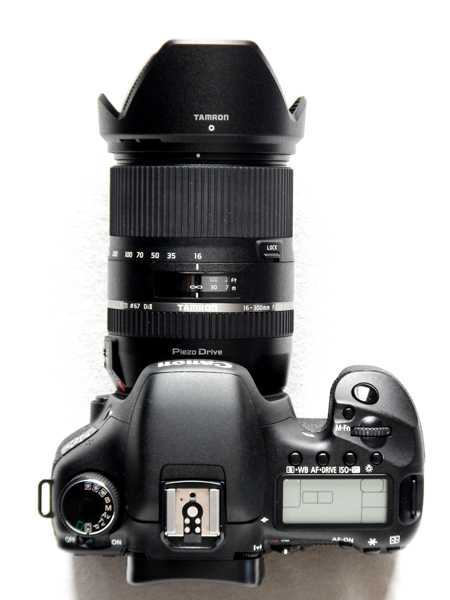
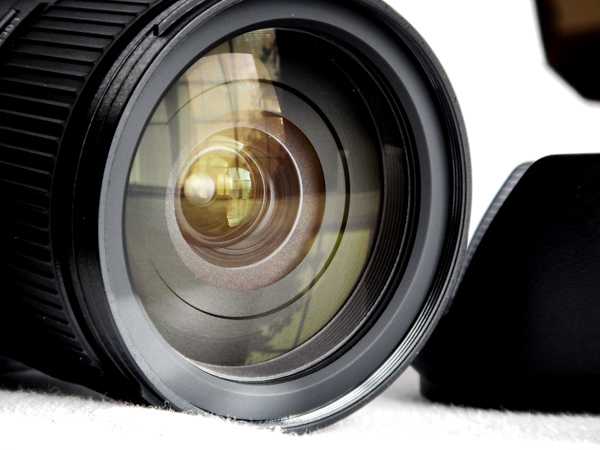
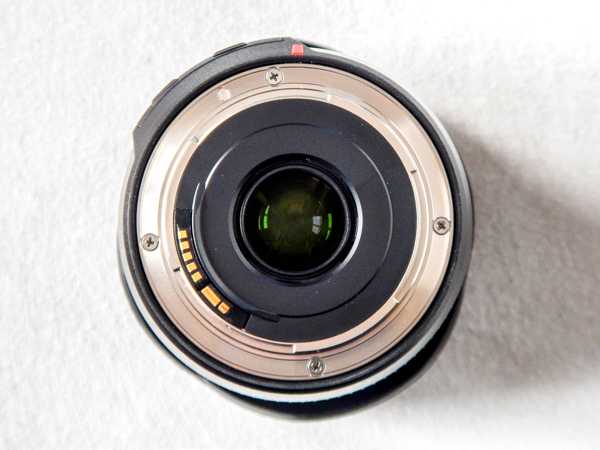
For the amount of zoom power that has been packed inside, I was very surprised at the shear compactness of this lens. Tamron’s 16-300mm is just under four inches in length at 3.9 inches (9.9cm). Here is a side-by-side comparison with my trusty Canon 28-135mm.
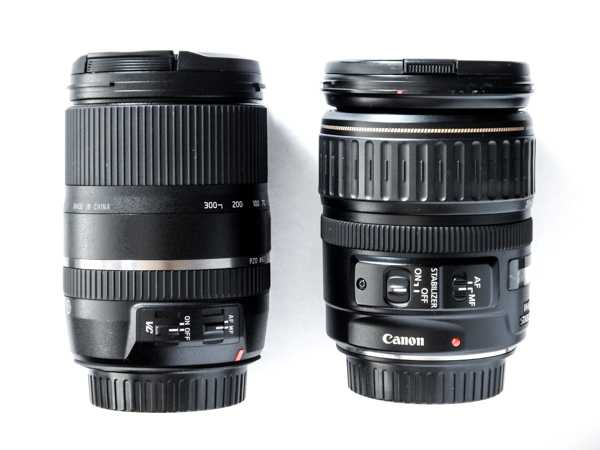
The lens feels very solid in hand and fits securely to the camera with no rattles or gaps. All of the on-lens controls are very crisp in their function and are well placed for easy no-look operation.
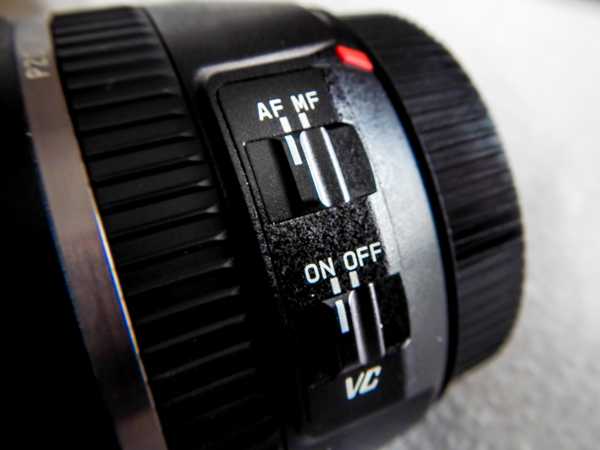
The rubber used for the zoom and focusing ring has just enough bite to securely adjust the lens, without the overly rubberized and sticky feel of some manufacturer’s lenses. Straight out of the box I did notice the the zoom was very tight – and I do mean tight. However, over the course of using the lens for a few weeks the tightness quickly lessened, and the zoom remained very responsive and firm for the duration of use.
Buy Now
Used Tamron AF 18-200mm f/3.5-6.3 XR Di II…
Heavily Used £49
Used Tamron 10-24mm f/3.5-4.5 Di II VC HLD…
Heavily Used £71
Used Tamron SP 15-30mm f/2.8 Di VC USD — N…
Heavily Used £219
Used Tamron SP 24-70mm f/2.8 Di VC USD — N…
Like New £374
Used Tamron SP AF 60mm f/2 Di II LD (IF) M…
Like New £159
Used Tamron AF 18-200mm f/3.5-6.3 XR Di II…
Like New £97
Used Tamron 17-28mm f/2.8 Di III RXD — Son…
Like New £629
Used Tamron SP AF 14mm f/2.8 Aspherical (I…
Like New £274
Used Tamron 18-400mm f/3.5-6.3 Di II VC HL…
Like New £604
Used Tamron 18-300mm f/3.5-6.3 Di III-A VC…
Like New £584
Sell or trade used photo and video kit with MPB
|
We don’t have the latest price however the link below will take you to the most relevant items. Tamron 16-300mm f/3.5-6.3 Di II VC PZD MACRO |
We don’t have the latest price however the link below will take you to the most relevant items. Tamron 16-300mm f/3.5-6.3 Di II VC PZD MACRO |
We transform the way that people buy, sell and trade in photo and video kit. USED GEAR |
Support this site by making a Donation, purchasing Plus Membership, or shopping with one of our affiliates:
Amazon UK,
Amazon US,
Amazon CA,
ebay UK,
MPB. It doesn’t cost you anything extra when you use these links, but it does support the site, helping keep ePHOTOzine free to use, thank you.
ADVERTISEMENT
Other articles you might find interesting…
Nikkor Z DX 24mm F/1.7 Lens Review
Fujifilm XF 8mm F/3.5 Review
Canon RF-S 55-210mm Review
SIGMA AF 14mm f/1.4 DG DN | Art Lens Review
Best Third Party Nikon F Lenses (DSLR)
Astrodesign & Samyang Join The L-Mount Alliance
Best Canon EF And EF-S Lenses
Sony FE 70-200mm f/4 G OSS II Lens Announced — Take A Look A…
Tamron 16-300mm f/3.5-6.3 Di II VC PZD MACRO Sample Photos
Previous
Next
Tamron 16-300mm f/3.5-6.3 Di II VC PZD Macro Lens Quick ReviewCanon EOS 7D
Value For Money
This 16-300mm lens costs around £530, which is very reasonable for a newly released lens, especially as the 18.8x zoom range is currently unique.
Canon’s closest offering is their EF-S 18-200mm f/3.5-5.6 IS USM lens, which costs around £370. However, this lens sacrifices 2mm from the wide and a whopping 100mm from the telephoto end, compared to this Tamron optic.
Nikon’s closest equivalent is their newly released AF-S DX 18-300mm f/3.5-6.3 VR lens, which costs around £615 and sacrifices 2mm for the wide end of the range compared to this Tamron.
Sony’s closest equivalent is their 18-250mm DT AF lens, which costs around £430, but sacrifices silent focusing with full time manual override, 2mm from the wide end of the zoom range, and 50mm for the telephoto end.
Finally, Sigma’s closest equivalent is their 18-250mm f/3.5-6.3 DC OS HSM lens, which costs around £300. Although this lens has silent focusing motor, it doesn’t allow manual overrides at any time. Also, like the Sony lens, it sacrifices 4mm from the wide end of the zoom range and 50mm from the telephoto end.
Tamron 16-300mm f/3.5-6.3 Di II VC PZD Macro review – Build and handling
The version of this Tamron 16-300mm f/3.5-6.3 Di II VC PZD Macro lens I had to test was fitted for Canon EF-S, so I chose to mount it on an EOS 70D – being perhaps at the upper end of the kind of camera with which we might expect this lens to be used. Extended or contracted, the lens makes a fine mate for the body. The two balance well, and while somewhat heavy for all-day carrying, it is no worse than most enthusiasts are prepared to lumber themselves with.
The lens is not especially small until one considers the focal range it covers, but it has a deceptive look of a lens that should be small. In fact, when collapsed to 16mm, it is not much longer or broader than we might expect a 90mm f/2.8 macro lens to be, and, apart from the dual rings, it does not look especially unlike one. Its ability to double its physical length when set to the 300mm mark is quite surprising, because this 16-300mm f/3.5-6.3 macro lens does not look like a mega-zoom lens. I was expecting something a little more brash and bulbous, more along the lines of the 150-600mm optic from Tamron’s SP series that I tested in AP 12 April. This model, by contrast, is ‘quietly designed’ and features a remarkably narrow barrel with a 67mm-diameter lens cap. It is designed to look small, and it does.
Tamron has used the same rectilinear grid pattern for the zoom and focus rings that we have seen in previous models, with the zoom control forward of the focus. These feel good to the touch and are easy to grip and turn even with thick gloves. A focus-distance scale sits between the two rings beneath a glass viewing window, creating a decent distance to distinguish one from the other when our eye is to the viewfinder. A rotation of a little over 120°, or a third of a full turn, takes the focus from 0.39m to infinity.
The build of the lens seems solid enough, and there’s not too much wobble when the three-part barrel is fully extended. The supplied hood is a little squidgy, but that flexibility may well protect it from breaking when under pressure.
A lock is provided that retains the barrels when stowed in the ‘home’ 16mm position, but it seems hardly necessary as, in this factory-fresh unit at least, there is more than enough resistance to counter the draw of the Earth’s gravity when the lens is pointing down or up.
The construction is a pretty complicated business, with 16 elements arranged in 12 groups. The more significant area is inevitably at the front end, where Tamron has used an element of only about 60mm in diameter made from the company’s ultra extra refractive (UXR) glass, the refractive properties of which are claimed by Tamron to play an important part in the miniaturisation of the whole unit. An additional forward lens is made from extra refractive (XR) glass, and there are four aspherical lenses to ensure good sharpness and contrast from all that light passing through highly refractive elements.
The Nikon and Canon versions of the lens have Tamron’s Vibration Compensation (VC) system, and these and the Sony-fitted model (which will be introduced at some time in the future) feature the so-far excellent Piezo Drive (PZD) near-silent and fast AF motor.
Tamron doesn’t go into a lot of detail on the subject of exactly how moisture-resistant the lens is, but there is a rubber skirt around the mount that should seal at least the join with the camera.
Introduction
The Tamron AF 16-300mm F/3.5-6.3 Di II VC PZD is a wide-angle to telephoto zoom lens designed for APS-C crop sensor DSLRs. Boasting a 35mm focal range of 24-450mm and features such as a Piezo Drive focusing motor, Tamron’s exclusive VC (Vibration Compensation) technology to combat motion blur, moisture resistant construction and a 39cm minimum focus distance and a maximum reproduction ratio of 1:2.9, the Tamron 16-300mm F/3.5-6.3 Di II VC PZD costs around £529 / $629 and is available in Canon, Nikon and Sony fit. The Sony model comes without the VC image stabiliser because Sony cameras already have it built into the camera body.
Tamron 16-300mm f/3.5-6.3 Di II VC PZD Macro Handling and Features
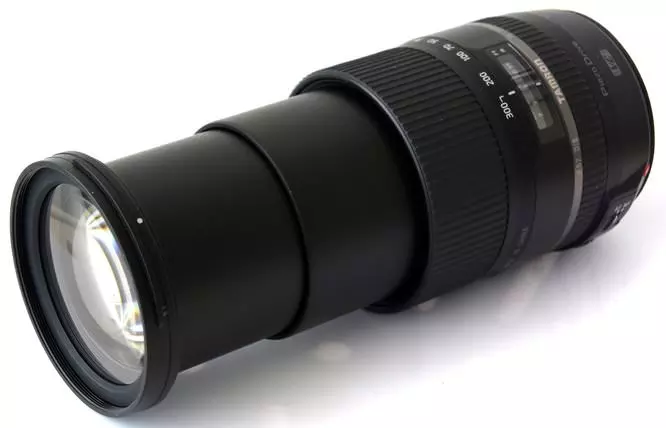
The absolutely huge zoom range offered by this lens, hasn’t compromised the size, with it having similar dimension to many 4x or 5x zooms lenses and it weighs only 540g. The low weight and compact size make this lens an ideal candidate as a walkabout lens for those times you may wish to travel light. It feels right at home on the Nikon D7100 body used for testing, and will make a good companion for smaller, more compact DSLR camera bodies as well. High quality plastics with a matte finish have been used for much of the construction of the lens barrel, and it feels reasonably robust as a result. A rubber gasket, located around the metal lens bayonet, will help to prevent the ingress of dust and moisture into the camera body.
A Piezo Drive motor powers autofocus and speeds are fairly quick, especially for a super-zoom lens. Manual adjustments can be applied at any time via the narrow focusing ring near the base of the lens. Manual focusing action is smooth and well damped, which makes fine adjustments a pleasure to apply. The zoom action is smooth and it doesn’t snag or tighten at any point in the zoom range. Just enough resistance has been applied to prevent the zoom creeping forward when it is pointed down, even so, a switch to lock the lens at 16mm is provided, to prevent the lens from extending accidentally when it’s removed from a case or bag.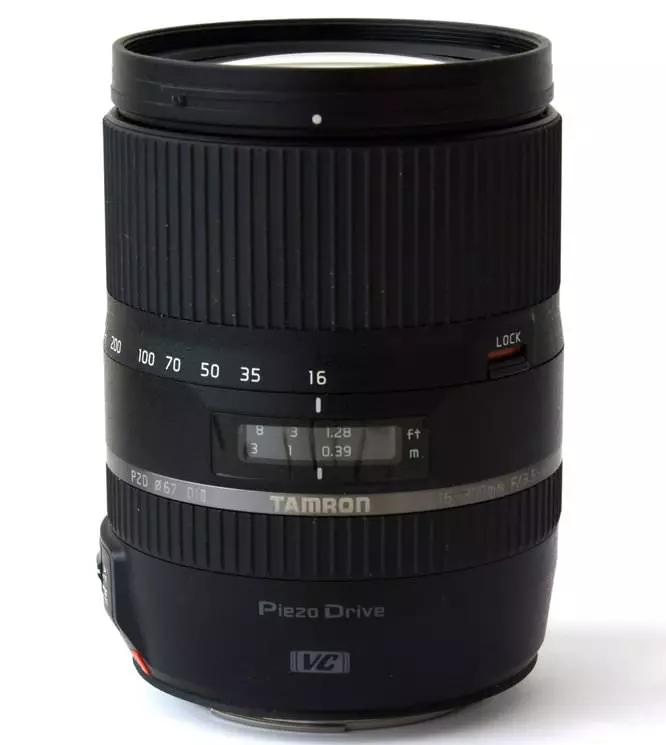
Closest focus distance is 39cm, which is very close for a lens that covers up to 300mm and focusing is performed internally. The 67mm filter thread does not rotate, which should make this lens ideal for use with graduated filters and polarisers. A petal shaped hood is supplied with the lens, which attaches to the front via a bayonet fitting.
Tamron’s Vibration Compensation system promises to allow hand-held shooting at shutter slower than the usual rule of thumb for sharp hand-held photos would allow. The system settles down quickly, providing a steady viewfinder image, although it is best to leave a short pause after focusing to ensure the system is properly settled. With care, sharp handheld shots were possible at shutter speeds as low as 1/15sec around half the time at 300mm, which is roughly five stops slower than the usual rule of thumb they recommend.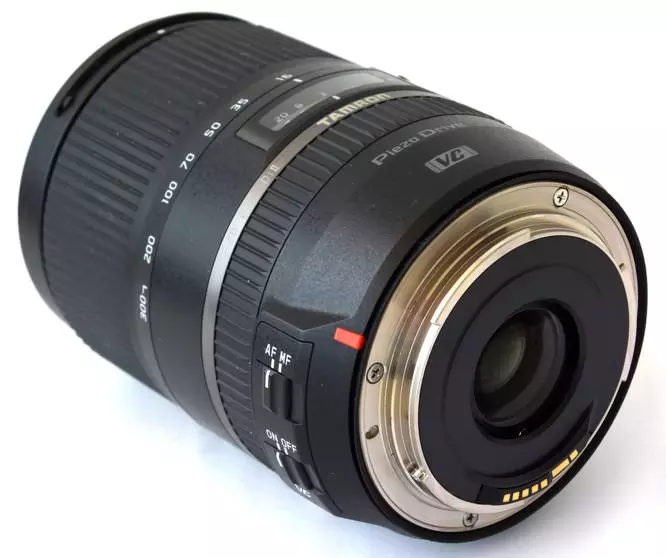
Tamron 16-300mm f/3.5-6.3 Di II VC PZD Macro review – Image quality
Images: With the lens set at 70mm, I shot this scene across the entire aperture range. You can see how resolution increases to f/11 and then falls off beyond f/16
Image quality is where we might expect to pay the price for the convenience of the all-in-one-type zoom. We should remember, though, that while £600 is a lot of money, this is in no way an expensive lens. At this price, and with all those focal lengths packaged into something very small, we shouldn’t expect first-class results. I am not preparing you with excuses, but just trying to temper my findings with a degree of reality.
I will begin with the worst – chromatic aberration. Coloured fringing is one of the more difficult optical problems to correct after the event – and beforehand too, it seems – yet it is one of the more obvious to the eye and therefore one of the most objectionable. There are some aberrations I can live with, but I find purple and green glowing edges around high-contrast areas very difficult to accept.
Images: Coloured fringing in distant subjects extends well into the frame at f/6.3. At f/11 fringing still exists, but it is less obvious in the centre of the frame
While there have been a number of occasions when those edges have appeared during this test, with red and cyan too, those occasions were fewer than I had expected. Some fringing appears in the extremes of the frame when the wider focal lengths are used, but at the longest end of the zoom the fringes become wider and creep their destructive way towards the centre of the image. We know that it is the extremes of a zoom that are used the most, and in one that features such reach that length will be used a great deal. I suspect, then, that fringing will have an impact on a disproportionately high number of images shot with this model. One way to reduce the effects of these fringes is to tidy them into narrow bands by using a small aperture, but we have to be careful that we don’t sacrifice resolution for the sake of a purple edge.
As one might expect, image sharpness does not come at either end of the aperture scale when using this lens. While the larger apertures are decent when coupled with wider and mid-range focal lengths, they perform less well at the longest ends of the zoom. I made a tripod-mounted comparison using the 70mm focal-length setting (about 100mm in 35mm terms) and found that at this focal length resolution starts well enough, at f/5, and gradually improves to a peak between f/11 and f/16, but then drops off rapidly to become worse at f/22 than it is at f/5. The peak is narrow and clearly defined. When shooting at the 300mm setting, I found the peak even narrower and quite difficult to find in distant subjects. Certainly f/6.3 and a focus point at infinity does not provide anything that looks sharp or even detailed, but when focused on a closer subject things improve a good deal. In fact, close-up the lens performs well. I photographed a duck’s head 6ft (2m) away at the 300mm setting and used an aperture of f/10, and I am impressed with the detail and texture captured.
Image: I found best resolution with the longer focal lengths comes with subjects that are close to rather than distant. The texture of this duck’s feathers is very well rendered at f/10
I had expected to write at length on the subjects of vignetting and curvilinear distortions, but on the darkening of corners the lens has rather disappointed me. While some fall-off in illumination is detectable in technical subjects, in the real-life situations in which I’d expect this lens to be used that darkening is not really noticeable.
Barrelling and pincushion distortion do make an appearance, though, bending lines close to the edges of the frame at almost all focal length positions. While the barrelling at the 16mm end is not as bad as it could be in distant subjects, when we focus on closer things it is an issue. A church interior, for example, will suffer only a little, but the small bedroom of your house might take on an obviously distorted look.
Beyond the 50mm mark, the bending switches to the other way – inwards in the middle – and we enjoy pincushion distortion, the slimming properties of which chubby faces appreciate so much.
Images: This top image demostrates the degree of barrelling present at 16mm. Most software will allow barrelling to be easily fixed
Lens Specifications
Here is the nitty gritty for this lens. The specifications are taken directly from the Tamron USA website. Please note that the lens I worked with was a Canon mount and these specifications are for Nikon mounts, but the numbers should be very similar.
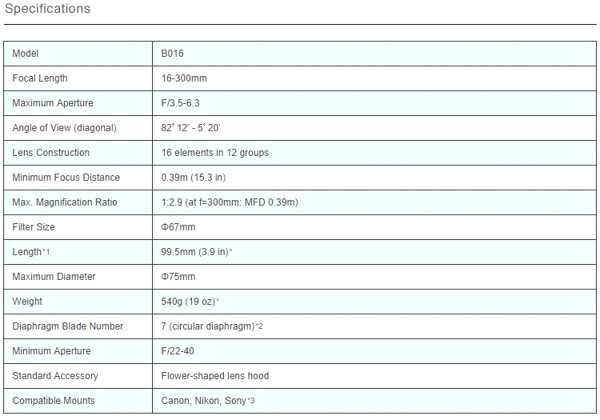
Let’s talk about all those letters on the side of the lens that were mentioned earlier and go over their meanings. The “Di-II” designation simply means that the lens is intended for use with digital SLR cameras. The “VC” means that the lens is equipped with a vibration compensation (image stabilizer) feature and the “PZD” indicates the lens has Tamron’s proprietary Piezo Drive autofocus mechanism.
Design
The Tamron 16-300mm F3.5-6.3 Di II VC PZD Macro has put on a little weight. At 540g, it’s gained 90g over the previous-generation 18-270mm, and it’s also about half an inch longer, but is still a relatively light and easy-handling package, keeping in line with class rivals. The modest F6.3 aperture at maximum focal length, in common with most superzooms, is a major factor in keeping weight and bulk down.
The most noticeable design change is the focusing ring that’s moved to the back, nearest the camera, and it’s a great improvement. It no longer rotates during autofocus and provides full-time manual override. Rotation is smooth and nicely weighted, if not quite one-finger light. The zoom action is heavier, though lump-free.
| The barrel telescopes out by an extra 80mm when zoomed to the long end, and with the lens hood fitted, the overall length more than doubles. | A zoom-lock at 16mm prevents the barrel from tromboning down by itself when carrying, but it wasn’t needed throughout the test period. |
Considering what the zoom mechanism has to do, shifting a lot of glass and almost doubling the total length, the small amount of wobble at full stretch is acceptable in a consumer-grade lens, and has no noticeable impact on image quality. A plastic petal-shaped lens hood is provided.
Although the lens is dubbed ‘macro’ this really refers to focusing a bit closer than usual, and it certainly goes nowhere near the 1:1 reproduction ratio that all true macros achieve. Nevertheless, it can focus down to within 9cm (3.5 in) of the front element, and at the 300mm focal length position, that’s a 1:2.9 reproduction ratio or 0.34x life-size. In real-world terms, it will fill the frame with a subject around 6cm wide (2.4 in) so it’s perfect for flowers and butterflies.
Build quality and finish are good. High quality engineering-grade plastics are very much in evidence, as they usually are these days even in the most costly lenses, so no criticisms there. The zoom and focusing rings certainly have a better feel than the previous model, and Tamron now claims moisture-resistant construction. How far that extends beyond a sealing-gasket around the lens mount is not given.
























